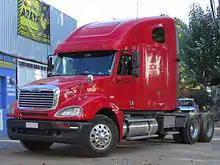
A 6×4 or six-by-four is a vehicle with three axles, with a drivetrain delivering power to wheels at the ends of two of them.[1] It is a form of four-wheel drive[2] but not one of all-wheel drive.
It is the most common form of drivetrain of semi-tractors[2] and heavy haul fixed-chassis cargo trucks in larger countries such as the United States and Australia; in Europe, 4×2 and 6×2 variants are more commonplace.
Off-road vehicles
.jpg.webp)
The First World War saw a great adoption of petrol-engined lorries, beginning to replace horse transport. These were almost all simple 4×2 chassis, often based on commercial lorries or buses. Only a handful of 4×4 vehicles existed and these were slow and lumbering, with complicated servicing needed to their steering axle.
Between the wars there was a great interest in the development of vehicles with better off-road performance, both for the military and for the growing oil exploration industry. More driven axles were needed, for better grip, but also a heavier load capacity which itself required an additional axle. This led to designs favouring the 6×4 layout and 4×4 was largely ignored at first, at least from the major truck makers.[3] Military 6×4 chassis were also easier to produce for civilian manufacturers, as they were more similar to chassis for the larger civilian market, often just with uprated components. A few aberrations of 6×6, 8×8 and even half-tracks were produced,[4] but these were mostly as gun tractors or recovery vehicles and were too complex and expensive for General Service trucks. The standard design became a 6×4 truck of 3 ton capacity,[5] along with larger trucks of 10 tons.[6]
Bogie suspension
With six wheels, the off-road performance often relied on articulation between the axles, so as to keep all the wheels in contact with uneven ground. A standard lorry chassis with live axles suspended by semi-elliptic leaf springs was inadequate for military use.
A solution to this was a bogie suspension. This coupled two rear wheels to a rigid frame or bogie but allowed this to tilt. The bogie pivoted freely for much of its range, allowing a greater movement than was possible with springs.[lower-roman 1][7] One of the best-known heavy tractor units of World War II, the Scammell Pioneer used this bogie system.[8][9]
Supplementary axles

Nearly all 6×4 have an unpowered leading steering axle, with two driven rear axles. However some mass-produced 4×4[lower-roman 2] vehicles have had their load-carrying capability increased by adding an additional, unpowered, rear axle.
The Carmichael Commando chassis, a stretched version of the Range Rover, was used for such extended 6×4 conversions in the 1970s and '80s. Some German conversions provided full 6×6 performance, but most were like the TACR2 and just 6×4. This gave a vehicle suitable for airfield emergency services; with fast performance on tarmac, useful off-road performance for crossing obstacles, increased load capacity and a much cheaper price than dedicated 6×6 vehicles.
See also
References
- ↑ Horstmann suspension did something similar for tracked vehicles and tanks, at around the same time.
- ↑ These have been mostly AWD vehicles with permanent 4WD and good road performance rather than the selectable 4WD used more widely for earlier off-road vehicles.
- ↑ International ProStar ES Class 8 truck: Axle configurations
- 1 2 NACFE (North American Council for Freight Efficiency) Executive Report – 6x2 (Dead Axle) Tractors Archived 2015-07-07 at the Wayback Machine "A typical three axle Class 8 tractor today is equipped with two rear drive axles (“live” tandem) and is commonly referred to as a 6 X 4 configuration meaning that it has four-wheel drive capability."
- ↑ Freathy, Les (2012). British Military Trucks of World War Two. Erlangen: Tankograd Publishing. pp. 11–14. ISBN 978-3-936519-29-7.
- ↑ Freathy (2012), p. 12.
- ↑ Freathy (2012), pp. 11–14.
- ↑ Freathy (2012), pp. 36–37, Albion CX.
- ↑ Tuck, Bob (1987). The Supertrucks of Scammell. Motor Racing Publications. pp. 16–17. ISBN 0 948358 01 7.
- ↑ Tuck (1987), pp. 21–22.
- ↑ Georgano, Nick (1997). "4: Cross Country, Military and Export, The Pioneer and its Descendants". Scammell: The Load Movers From Watford. Roundoak Publishing. pp. 36–38. ISBN 1 871565 26 X.